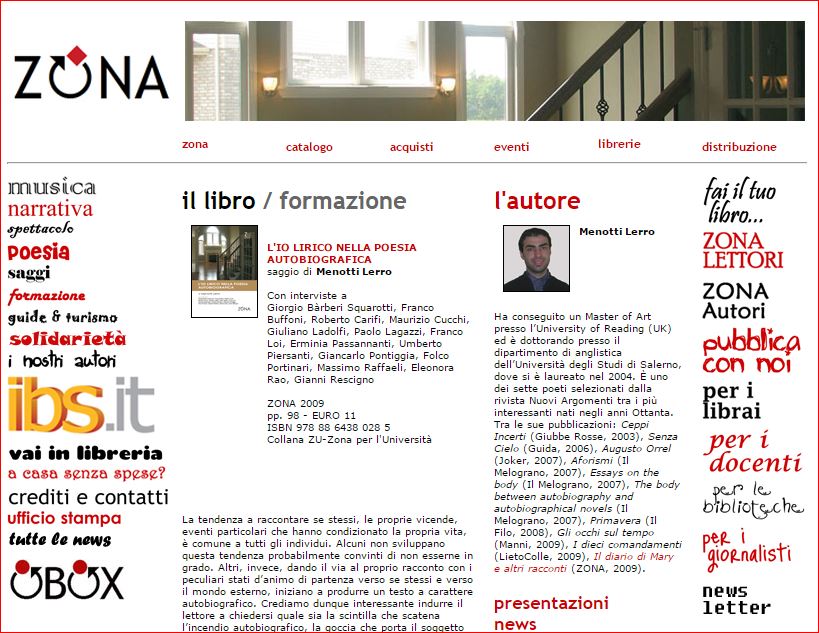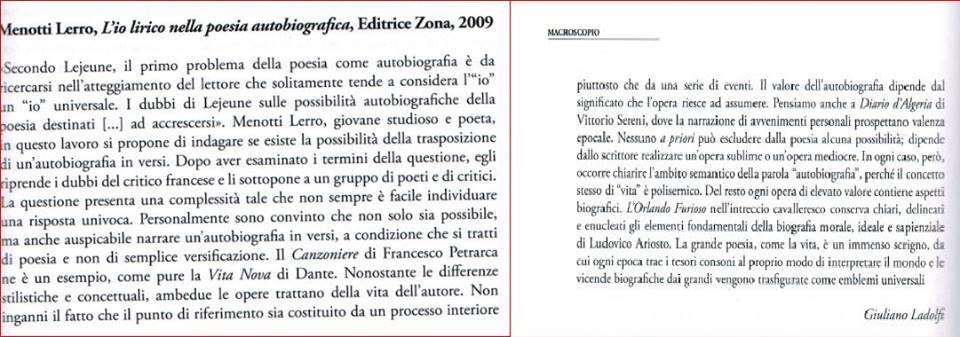L’io lirico nella poesia autobiografica
Menotti Lerro. L’io lirico nella poesia autobiografica. Civitella in Val di Chiana (AR): Editrice Zona, 2009. Pp. 96.
Menotti Lerro’s recent volume confronts the complex issue of self-depiction in modern Italian poetry, a genre that has been more problematically associated with the notion of autobiography than prose. Philippe Lejeune’s seminal (yet restrictive and now contested) definition of autobiography in Le Pacte autobiographique (1975) as a retrospective narrative of the self in prose is placed at the centre of the theoretical discussion that constitutes the first half of this book. In his cogent analysis that acknowledges Lejeune’s problematic exclusion of poetry from the autobiographical canon, Lerro charts a brief history of autobiographical writing, definitions thereof and the specific categorization of the “autobiografia in versi.” Italian Bookshelf 575 The second section consists of a collection of interviews that Lerro conducted with contemporary Italian poets: Giorgio Bàrberi Squarotti, Franco Buffoni, Roberto Carifi, Maurizio Cucchi, Giuliano Ladolfi, Paolo Lagazzi, Franco Loi, Erminia Passannanti, Umberto Piersanti, Giancarlo Pontiggia, Folco Portinari, Massimo Raffaeli, Eleonora Rao, Gianni Rescigno. In the course of these interviews, Lerro poses a number of questions relating both to more abstract notions of the problem of “life writing” — e.g., “Si può dire che ogni opera è in qualche modo autobiografica, poiché sempre riflette l’esperienza della vita dell’autore?” (64); “Qual è il limite e il vantaggio (se ce ne sono) di narrare un’autobiografia in versi, rispetto a farlo in prosa?” (82) — and to the way in which the interviewees address this problem in their own work. What is more, through questions such as, “Cosa pensa delle affermazioni di Eliot che propugnano l’impersonalità necessaria delle arti?” (60), Lerro encourages these contemporary poets to reflect upon the practices of a number of key figures in the modern poetic imaginary who have made influential statements on the “opera-vita” binomial. These poets include T. S. Eliot and Giuseppe Ungaretti, indubitably canonical figures in any discussion regarding text-life relationships. This book establishes a number of fundamental problems involved in defining autobiographical poetry, particularly in the Italian and English traditions. At the same time, because of its limited space, the volume cannot offer a systematic treatment of the topic, a task that a larger-scale study might aim to undertake. While this lack of definitive answers may indeed be a telling feature of the way in which autobiography constantly seems to elude definition, in the first section Lerro might have interrogated at greater length the issue of form by considering to what extent writing in a prosaic “verso libero” is a consistent feature of poetry that aims to represent aspects of the life of the poet — in fact a question that a number of the subsequent interviewees address. The intensification of a pronounced “dialogismo” in the poetry of the “secondo Novecento,” analyzed in depth by Enrico Testa in Per interposta persona (Roma: Bulzoni, 1999), is another defining feature of the lyric subject at hand, one to which a broader study on this issue might potentially pay further attention. Divided in two sections, the volume could have developed a greater cohesion in its two parts. The study is clearly a stimulating introduction to the topic, so much so that readers might wish for a more in-depth analysis of the myriad reactions of the contemporary interviewees, whose answers display a range of responses, from the comprehensive and incisive (e.g., Pontiggia, Raffaeli) to the skeptical and reticent (e.g., Buffoni, Cucchi). This work’s two sections doubtlessly help the reader to establish key coordinates in the discussion of the tensions inherent in poetic projects that involve depicting an autobiographical self, both from a theoretical and practical point of view. The scope of the volume is defined as pertaining predominantly to autobiographical poetry in the second half of the twentieth century, a period in 576 Annali d’Italianistica 29 (2011) which Lerro perceives a “forte impulso a [questo] genere letterario” (15). Certain Italian models of the lyric tradition, such as Dante and Petrarch, constitute a consistent point of reference in the interviews in the second section (e.g., by Ladolfi 81) and thus, in this reviewer’s mind, might have been given greater weight in the diachronic account of the first section. Lerro’s work alludes – and rightly so – to the problem of a discontinuous fragmented “lyric I” that we often associate with the poetic subject in the latter half of the twentieth century. Precisely for this reason he might have engaged at greater length with theorists such as Paul De Man and Jacques Derrida who have attempted to redefine and deconstruct the subject’s relationship with any known fixed entity, including that of the self. Notions of performativity and gender (such as in the work of Judith Butler and Adriana Cavarero) might also have been used to greater effect in the volume, which, because of its brevity, cannot deal in depth with questions of gender, race or sexuality, and the implications of these issues for a poetic mode of self-representation. These theorists, who are mentioned in passing both by Lerro himself in the theoretical introduction, and by a number of the interviewees, are by necessity situated outside the scope of the volume, and yet they might prove interesting critical touchstones for a larger and more exhaustive study. Lerro’s choice of interviewees allows for a fascinating range of responses from Italian contemporary poets. Whilst one might have wished to find a clearer outline of the reasons behind Lerro’s selection of interviewees, one cannot but praise the author’s desire to be as comprehensive as possible in his selection, even though it may seem somewhat arbitrary. Given the brevity of the volume, one cannot quibble with the limitations of the final bibliography, or the few entries from unexpected sources, including online encyclopedias and dictionaries. Such studies as Franco D’Intino’s L’autobiografia moderna: storia forme problemi (Roma: Bulzoni, 1998), and Il testo autobiografico nel Novecento (ed. Reimar Klein and Rossana Bonadei, Milano: Guerini e Associati, 1993) might have proved stimulating points of reference. In the main, Lerro’s volume provides both a most useful introduction to some of the issues at stake in depicting the modern self through poetry, and an interesting account of the way in which a selection of contemporary poets view their relationship with the complex process of writing the self.
Eleanor Parker, University of Oxford on “Annali d’italianistica”
(Il libro L’io lirico nella poesia autobiografica rappresenta un’introduzione al genere autobiografico. Per un consistente approfondimento sul tema rimando al volume Raccontarsi in versi. La poesia autobiografica in Inghilterra e in Spagna (1950-1980), Carocci 2012); ovvero alla versione rivista e aggiornata in lingua inglese Autobiographical Poetry in England and Spain: 1950-1980, (CSP, 2017).


